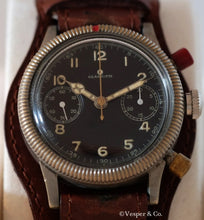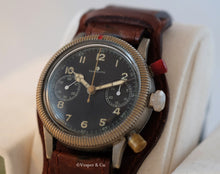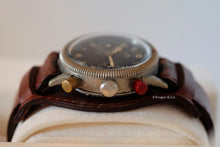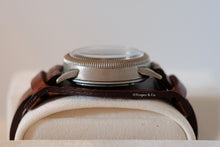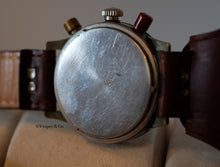
Glashütte. A Rare Chronograph Wristwatch Issued by the German Airforce
Case No: 206xxx
Circa: 1943
UROFA 59-caliber mechanical movement, 17 jewels, black matte dial, luminous Arabic numerals, outer minute divisions with Arabic numerals, luminous hands, two sunken subsidiary dials for 30 minute register and constant seconds, circular nickel-plated brass case, reeded bezel with red arrow, two round chronograph buttons in the band, downturned lugs, snap on case back, case, dial, and movement signed
38.5mm
More about Glashütte:
The tradition of German watchmaking goes back several centuries, with a flourishing watch community in Glashutte. However, after World War I, Germany was prohibited from military aviation, so there were no official aviation watches being produced. Nevertheless, in the 1920’s and 1930’s there were pilot’s watches in circulation, produced by Swiss makers such as Omega, Longines, and a few manufactured by IWC. By World War II, many of the chronograph wristwatches for the German airforce were produced in Germany by Ührenfabrik AG Tutima of Glashütte, Saxony, and by Hanhart of Schwenningen on the Neckar. Hanhart first began producing aviator chronographs in 1939, while Tutima started in 1941.
The watches by both brands were similar in appearance, having a rotating bezel with a marker for time, chronograph function for timing up to 30 minutes, and did not display any type of military marking. They also featured black dial faces with radium-coated luminous hands and Arabic numerals for easy reading in poor visibility. Early examples featured seamless cases, where the lugs were part of the case, while on later examples, the lugs were soldered to the case. On most examples, the pusher button for resetting the chronograph was coated in a red enamel to clearly indicate its purpose, so the wearer would not accidently push it. Hanhart also produced examples with a single chronograph button that controlled the start, stop, and reset functions. Aside from the manufacturer’s name on the dial, the watches were also distinguishable by the asymmetry of pusher – the top pusher on Hanhart watches touches the upper right lug, while the bottom pusher on Tutima watches touches the lower right lug.
The Tutima company was founded in 1927 by Dr. Ernst Kurtz, the managing director of Ühren-Rohwerk-Fabrik Glashütte AG (UROFA). In the 1940’s, UROFA developed the flyback chronograph caliber 59, and used this movement in Tutima watches that were supplied to the German military. It is estimated that approximately 15,000 chronographs were produced for the German airforce, but following the war, most were returned upon completion of a pilot’s mission. Early examples are particularly sought-after by collectors, and are often not in very good condition or heavily restored. Being cased in nickel-plated brass, many examples have cases where the brass is showing through worn plating. The present example is in excellent overall condition, with the plating all intact, a crisp case number engraved on the back, and a beautifully aged original dial.
While vintage military watches are becoming increasingly popular in today’s market, it is interesting to note that actor Steve McQueen, known for wearing a Heuer Monaco and a Rolex Submariner, also owned and wore a Hanhart chronograph produced for the German airforce.
Sources: Militäruhren – Military Timepieces, by Konrad Knirim, Second Edition 2002.





